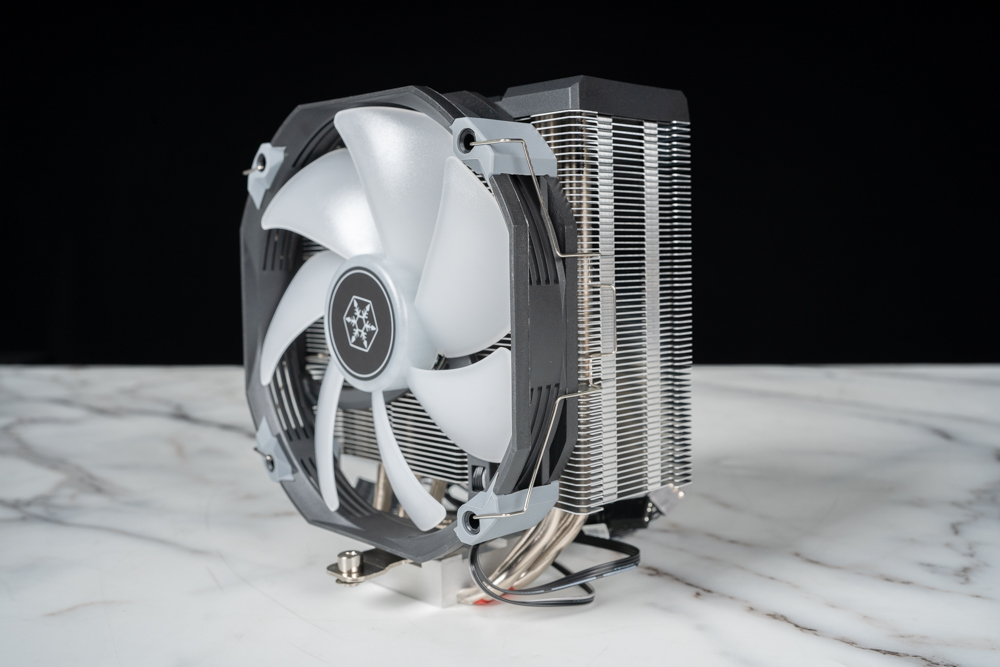
The SilverStone Argon V140 ARGB CPU Cooler is a high-performance cooling solution for modern processors. It’s compatible with a range of Intel and AMD sockets, including Intel LGA 2066, 2011, 1700, 1200, 115x, and AMD Socket AM4 and AM5. This cooler features four 6mm nickel-plated copper heat pipes and aluminum fins for efficient heat dissipation. The heat pipes make direct contact with the CPU to ensure optimal thermal conductivity.
A key feature of the Argon V140 ARGB is its large 14 cm-wide heat sink tower paired with a 14cm RGB fan, which has seven semi-transparent blades. This combination offers a large cooling area and high airflow, enhancing the cooling performance. The fan’s speed can be controlled via PWM in the range of 400 to 1,750 RPM, allowing for quiet operation during idle periods.
Specifications of the SilverStone Argon V140 ARGB CPU Cooler:
- Model: SST-ARV140-ARGB
- Dimensions: 81 x 140 x 160 mm (Depth, Width, Height)
- Weight: 820g
- Supported CPU Sockets: Intel LGA 2066, 2011, 1700, 1200, 115x; AMD Socket AM4, AM5
- Heat Pipes: Four Ø 6mm nickel-plated copper heat pipes
- Fan Size: 140mm x 140mm x 25mm
- Fan Airflow: 93 CFM
- Fan Air Pressure: 2.24mmH₂O
- Fan Speed: 400~1,750 RPM (± 10%)
- Noise Level: 12.8~30.8 dBA
- Materials: Copper heat pipes and aluminum fins
- Bearing Type: Hydraulic bearing
- Maximum Input Current: 0.17A
- Maximum Input Voltage: 12V
- Mean Time Between Failures (MTBF): 30,000 hours
- Fan Connector: 4 Pin PWM
- RGB Connector: 4-1 Pin ARGB (5V LED)
Unboxing the ARGON V140 ARGB: A Comprehensive Guide to Specs and Contents
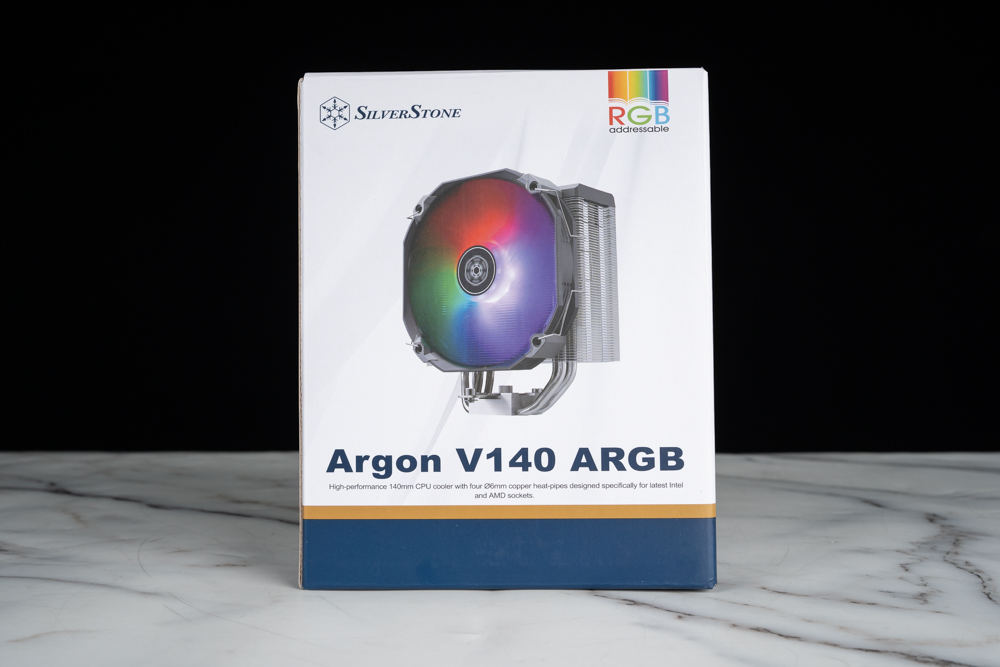
The packaging appears to be well-designed, prominently featuring the product with its RGB lighting on display. It also highlights that the cooler is compatible with the latest Intel and AMD sockets, which is a key selling point for consumers looking to upgrade their cooling systems.

The product packaging for the SilverStone Argon V140 ARGB CPU cooler. It lists both the features and specifications of the cooler, providing valuable information for consumers on what to expect from the product.
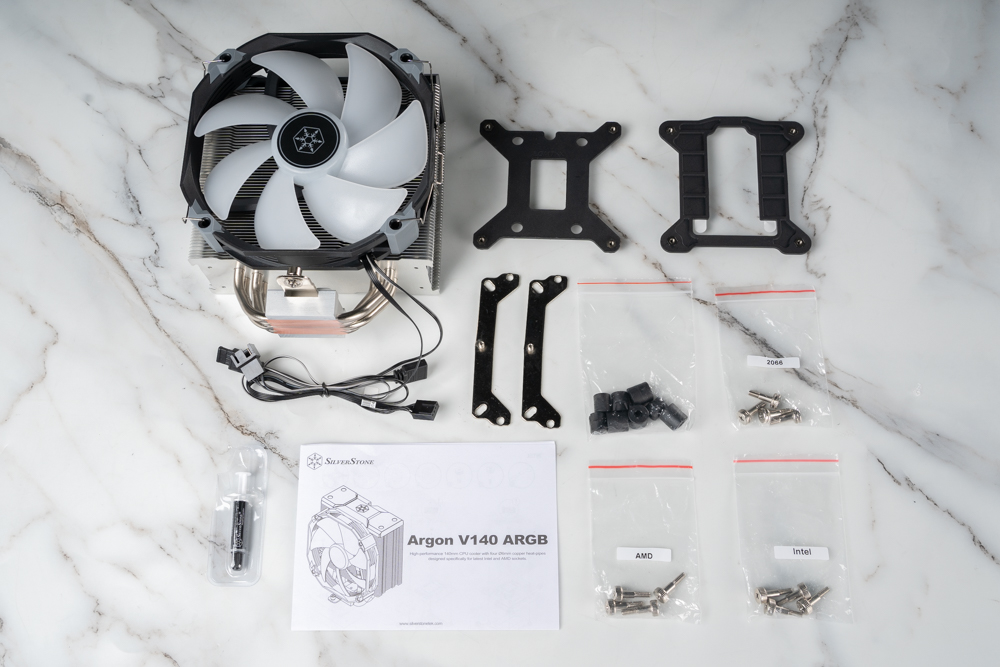
The complete set for the SilverStone Argon V140 ARGB CPU cooler. It includes the cooler itself, which features a distinctive white fan blade design set against a black frame and silver body, showcasing the nickel-plated copper heat pipes. Accompanying the cooler is an installation guide, which will be crucial for users to properly set up their new hardware. Also present are the mounting brackets and various screws and parts neatly packaged and labeled for AMD and Intel sockets, ensuring compatibility with a variety of CPU models. There’s a syringe of thermal paste, essential for facilitating efficient heat transfer between the CPU and the cooler.
This kit seems to provide all the necessary components for a user to install the cooler onto their system, along with the thermal compound to ensure a good thermal connection.
ARGON V140 ARGB Cooling Mastery: 14cm Heat Sink Fins and Advanced RGB Fan Features
To enhance cooling efficiency, the ARGON V140 ARGB features a large 14cm heat sink fin tower, paired with a 14cm RGB fan equipped with seven semi-transparent blades. This substantial cooling area combined with a high volume of airflow significantly boosts heat dissipation. The fan’s speed can be fine-tuned using PWM control, allowing the motherboard to optimize fan speed based on the CPU temperature. This not only makes cooling more efficient but also reduces unnecessary power waste.
The ARGON V140 ARGB utilizes an offset fin design for the heat sink, ingeniously avoiding interference with the memory modules, which means there are no restrictions on the height of the memory. Differing from other brands, this cooler employs a full-cover shock-absorbing rubber design on the fan, dramatically reducing vibration and noise.
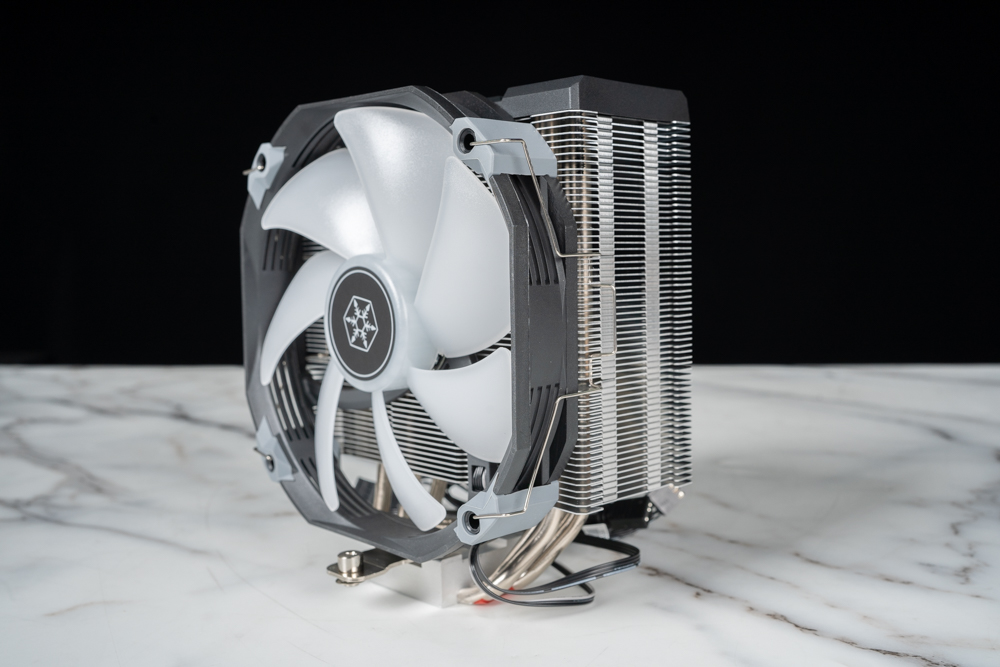
The cooler’s sleek design is evident, with its large stack of aluminum heat sink fins providing a substantial surface area for heat dissipation. The white fan, adorned with the SilverStone logo, adds a touch of elegance to the unit, and its size suggests it can move a significant amount of air, which is crucial for maintaining optimal CPU temperatures.
Moreover, you can see the nickel-plated copper heat pipes that are designed to directly contact the CPU, enhancing the heat transfer efficiency. The attention to detail in the build and the overall aesthetic suggests that it’s a product designed for enthusiasts who value both form and function in their PC builds.
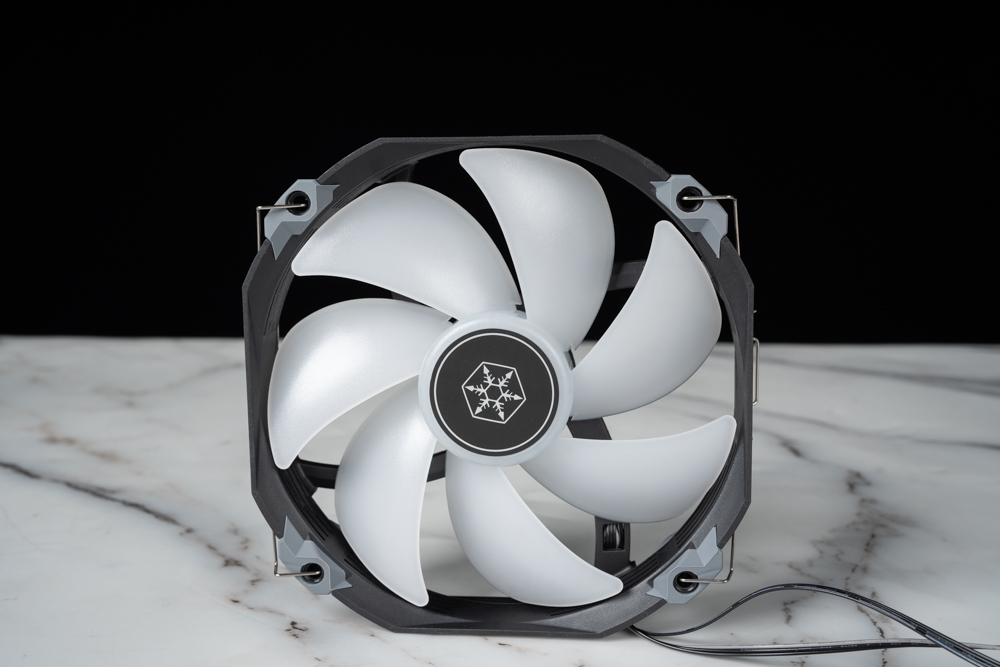
The fan which is part of the ARGON V140 ARGB CPU cooler, features an innovative octagonal design. This design choice deviates from the traditional square-shaped fans typically seen in CPU coolers, giving it a unique and modern aesthetic. The white blades of the fan contrast sharply against the black frame, highlighting the fan’s design and the SilverStone logo at the center.
The eight-sided frame not only contributes to the visual appeal but may also serve a functional purpose, potentially influencing airflow and noise characteristics for improved performance. This design element might appeal to those who are looking for a cooler that stands out in their computer build both in terms of style and functionality.
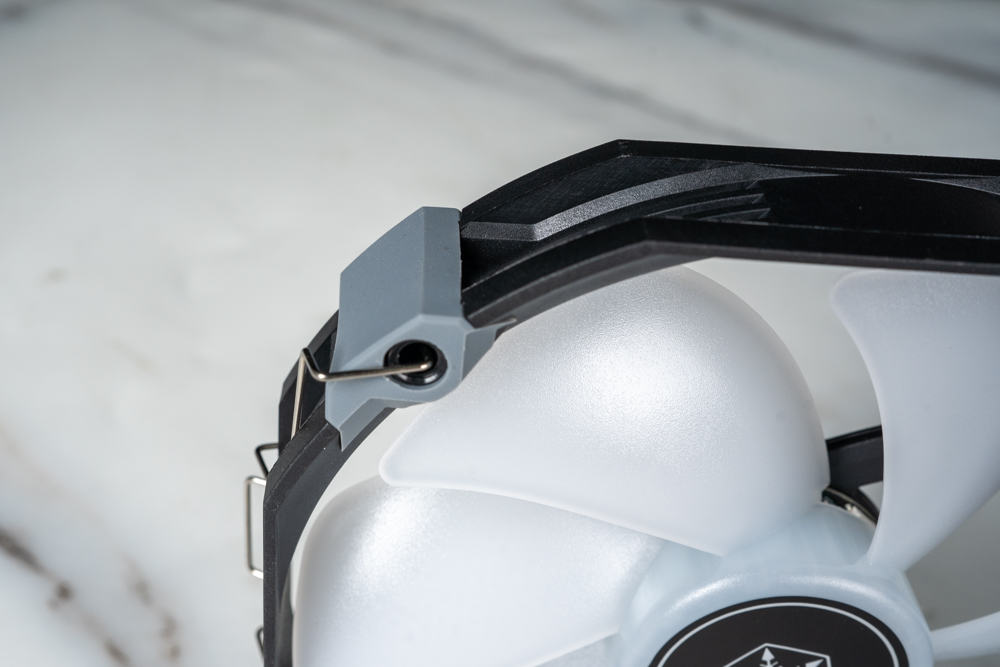
A detailed view of the ARGON V140 ARGB CPU cooler’s fan, highlighting the anti-vibration rubber pads located at each corner of the fan’s octagonal frame. These full-cover shock-absorbing rubber pads are strategically designed to dampen vibrations and minimize resonance noise when the fan is in operation.
By incorporating such features, the design indicates a careful consideration of both acoustic performance and the longevity of the fan, ensuring that vibrations are less likely to be transferred to the chassis or the CPU cooler structure. This thoughtful inclusion underlines the product’s commitment to providing a quieter cooling experience, which is a significant aspect for users who prioritize a silent operation in their computing environment.
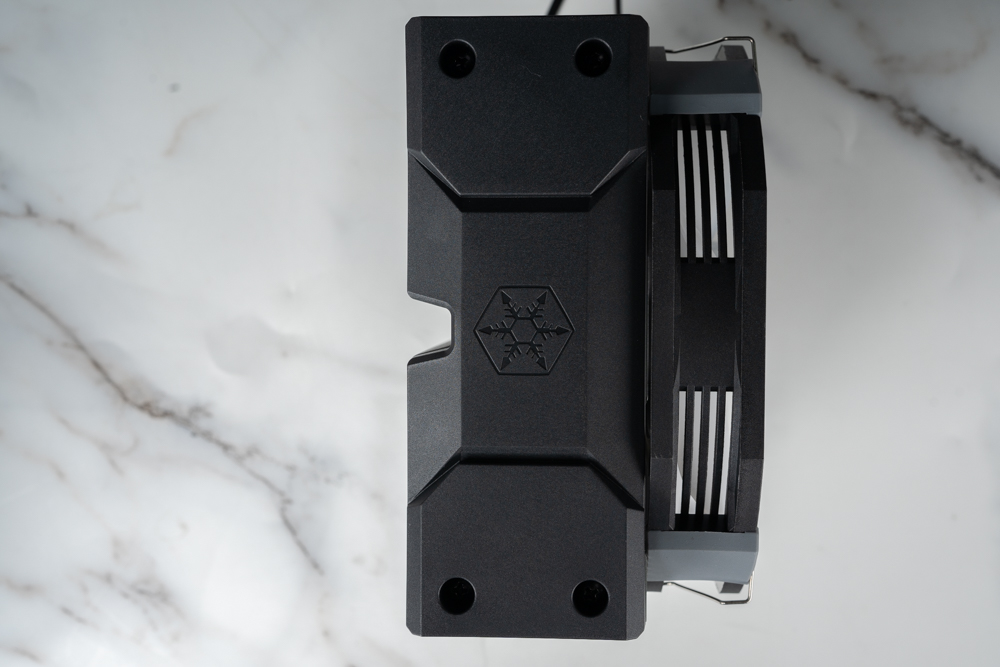
The top view of the ARGON V140 ARGB CPU cooler, showcasing the top cover with the etched SilverStone snowflake logo. The logo, which is a distinctive mark of the brand, is prominently displayed, giving the cooler a signature look that is both sophisticated and recognizable.
The top cover design not only adds to the aesthetic appeal but also serves to protect the fin structure of the heat sink beneath. The etching of the logo provides a subtle yet effective branding touch without overpowering the cooler’s overall design. This element could be a focal point in marketing materials, emphasizing the brand identity and the product’s attention to detail.
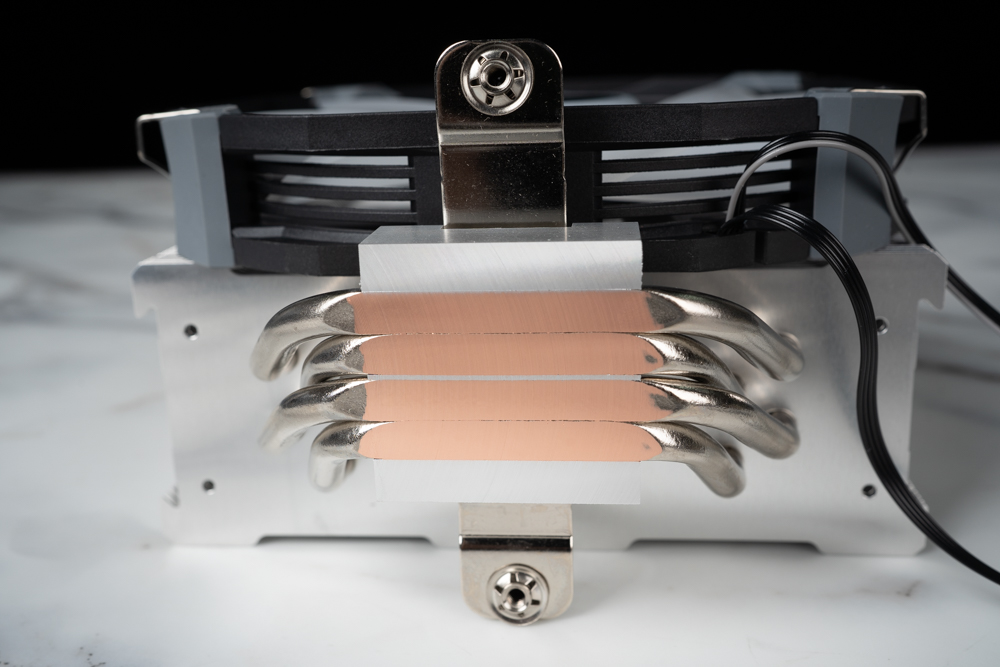
A detailed view of the lower part of the ARGON V140 ARGB CPU cooler, where the design incorporates direct-touch heat pipes. These heat pipes are in immediate contact with the CPU surface, a design choice that typically leads to more efficient heat transfer compared to designs where a base plate is used to separate the heat pipes from the CPU.
The copper heat pipes are shown here without any thermal compound applied, highlighting their polished finish and the precision with which they have been aligned. This close contact ensures that heat is quickly and efficiently conducted away from the CPU and into the heat sink, where it can be dissipated by the airflow provided by the fan.
The direct-touch approach is advantageous for users looking for high-performance cooling solutions, as it can significantly lower CPU temperatures, particularly under heavy loads or overclocking scenarios.
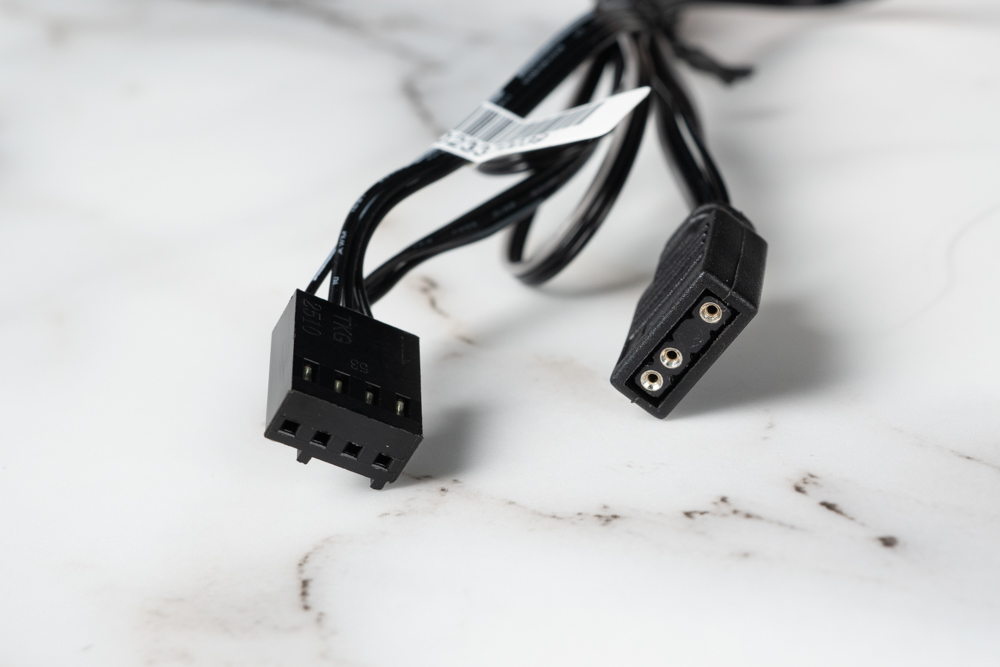
These two connectors are crucial for the operation and functionality of the ARGON V140 ARGB CPU cooler. The first is a 4-pin fan connector, which is typically used to connect the cooler’s fan to the motherboard. This connector allows for PWM (Pulse Width Modulation) control, enabling the motherboard to regulate the fan speed based on temperature readings, ensuring efficient cooling performance while minimizing noise.
The second is a 3-pin ARGB (Addressable RGB) connector, which is used for connecting the cooler’s RGB lighting to a compatible ARGB header on the motherboard or a dedicated controller. This allows the user to customize and control the lighting effects, such as color and patterns, to match their system’s aesthetic or personal preference.
These connectors are a testament to the cooler’s modern design, catering to users who value both performance and the ability to personalize their PC build’s visual appeal.
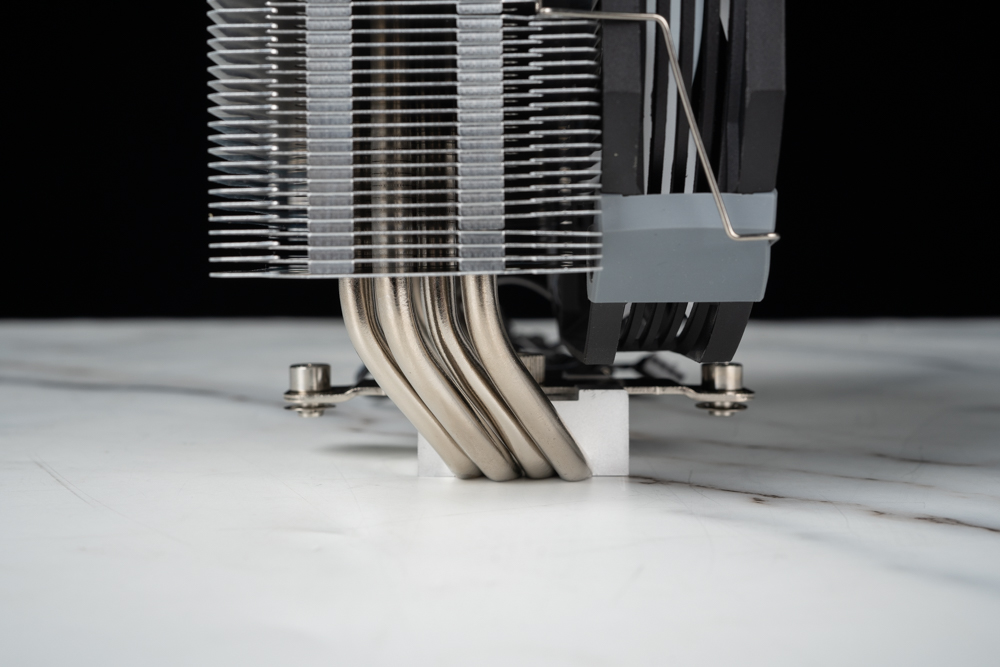
A side view of the ARGON V140 ARGB CPU cooler illustrates the offset design that allows for better clearance around the memory slots on a motherboard. This feature is particularly important for ensuring that the cooler does not obstruct the installation or removal of RAM modules, which can sometimes be a concern with larger coolers.
The heat pipes curve away from the area above the RAM slots, indicating that the design is mindful of the spatial constraints within a PC case. Users with high-profile memory modules will find this design advantageous as it allows for more freedom in selecting RAM without worrying about physical interference from the CPU cooling solution.
Such a design consideration speaks to the practical needs of builders and upgraders who require a balance between robust cooling performance and compatibility with a range of hardware configurations.
ARGON V140 ARGB: Seamless Installation and Striking Lighting on Intel and AMD Platforms
The SilverStone ARGON V140 ARGB is a versatile CPU cooler compatible with a variety of Intel and AMD sockets, including Intel’s LGA 2066, 2011, 1700, 1200, 115x, and AMD’s AM4 and AM5. It features a robust all-metal mounting kit for a secure installation. For demonstration purposes, installations on two different motherboards are showcased: the ASUS ROG STRIX Z690-E GAMING WIFI for Intel LGA1700, and the ASROCK B650E TAICHI for the AMD AM5 platform.
When installing on the Intel platform, it is critical to first assemble the backplate components correctly. It is important to note that the backplate and standoffs used for the Intel LGA1700 are different from those used with other platforms. Careful attention to the specific requirements of the LGA1700 socket is necessary to ensure a proper fit and optimal thermal performance.
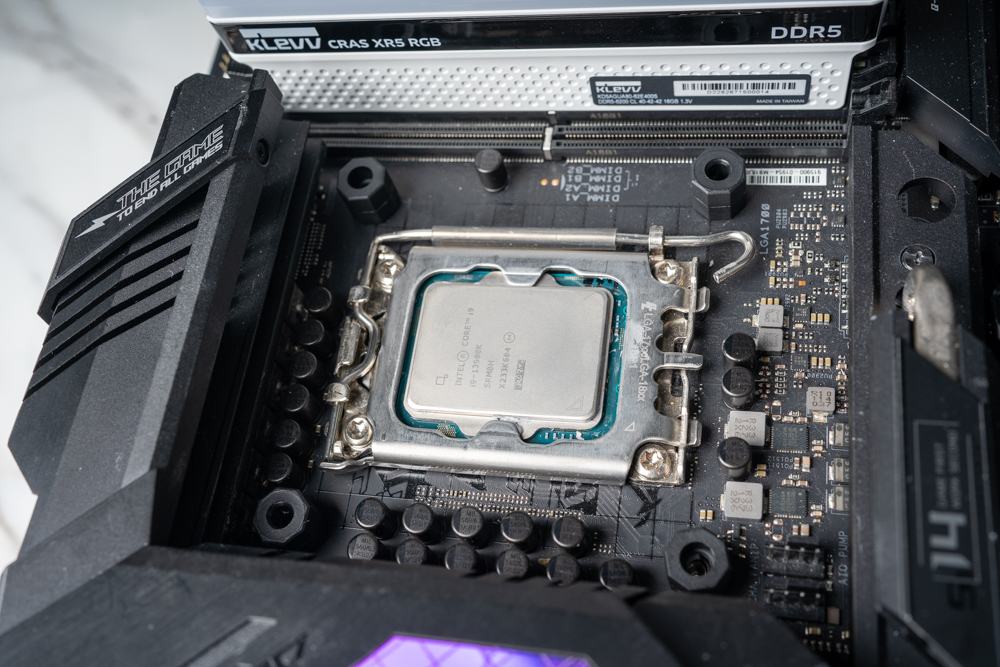
The image illustrates the initial step of installing a CPU cooler onto a motherboard, showing the backplate in place and the standoffs installed from the front side. The motherboard’s CPU socket is exposed with the processor installed, ready for the cooler to be mounted.
The standoffs, which are usually made of plastic or metal depending on the cooler design, are positioned to hold the backplate securely against the motherboard. These serve as the anchor points for the cooler’s bracket, which will be attached in the following steps.
The presence of high-profile DDR5 memory modules adjacent to the CPU socket indicates the need for careful cooler selection to avoid clearance issues. The image captures the importance of precision and attention to detail during the installation process to ensure a secure fit and optimal performance of the cooling system.
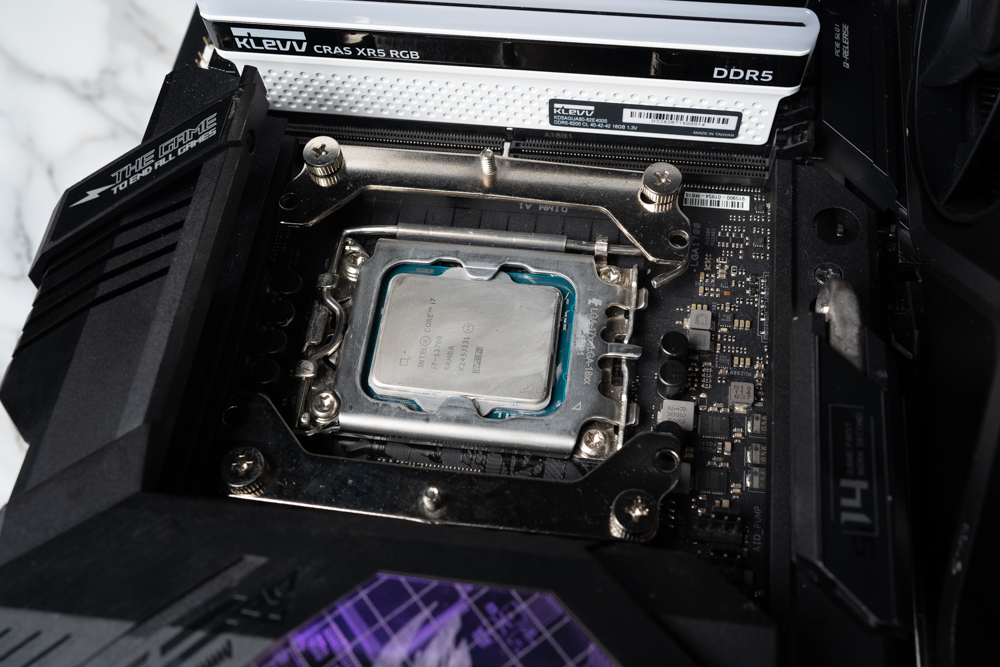
The next step is the installation of a CPU cooler onto the motherboard. After the backplate and standoffs have been put in place, the mounting bracket or retention bracket has been positioned over the CPU socket and secured with screws.
The mounting bracket is crucial as it provides a stable foundation for the CPU cooler to be attached. The screws are tightened to a specified torque to ensure that there is even pressure on the CPU, which is vital for effective thermal transfer.
In this step, it’s essential to ensure that the bracket is aligned correctly according to the cooler’s installation instructions and that the screws are tightened in a cross pattern to avoid uneven pressure on the CPU. It’s also important to not overtighten the screws to prevent damage to the motherboard.
The preparation shown in the image is meticulous, indicating that the cooler’s installation is nearly complete, with the next steps typically involving applying thermal paste, placing the cooler, and securing it to this bracket.
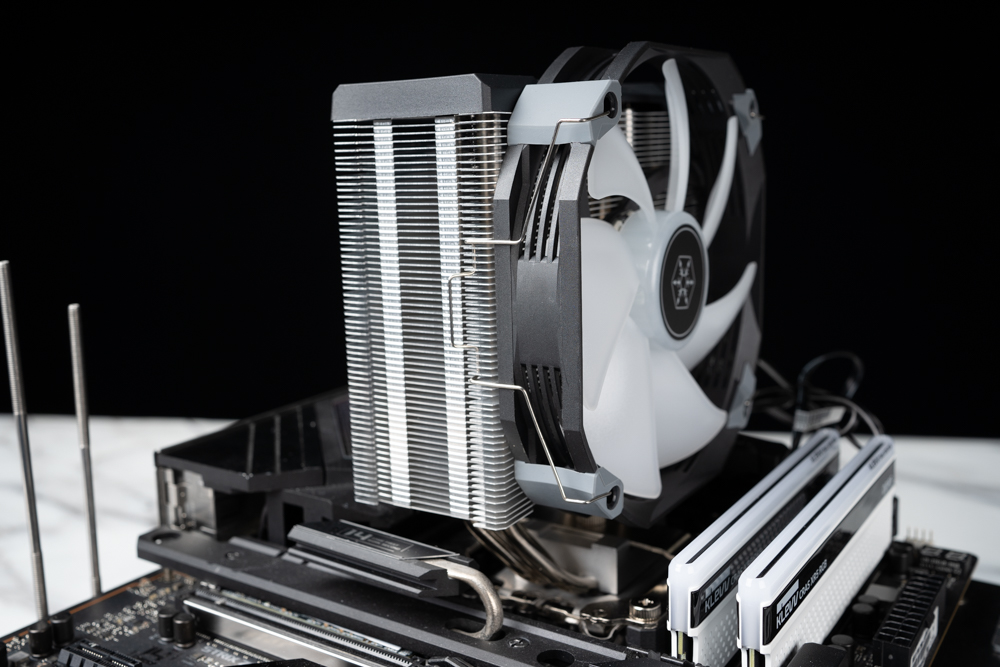
The image shows the ARGON V140 ARGB CPU cooler fully installed onto a motherboard. The thermal paste has been applied to the CPU, which is crucial for ensuring efficient heat transfer from the CPU to the heat pipes of the cooler. The cooler is mounted onto the prepared bracket and secured with screws.
The cooler’s orientation is such that it allows for good airflow through the fins and out of the case, which is important for optimal cooling performance. The fan is also attached to the heat sink, ready to draw air through the fins to dissipate the heat away from the CPU.
The installation process looks clean and professional, with the cooler’s fan and heat sink aligning well with the surrounding components, including the RAM modules, which remain accessible thanks to the cooler’s design.
This final image signifies a successful installation, and the system is likely ready for operation to see the performance benefits of this cooling solution.
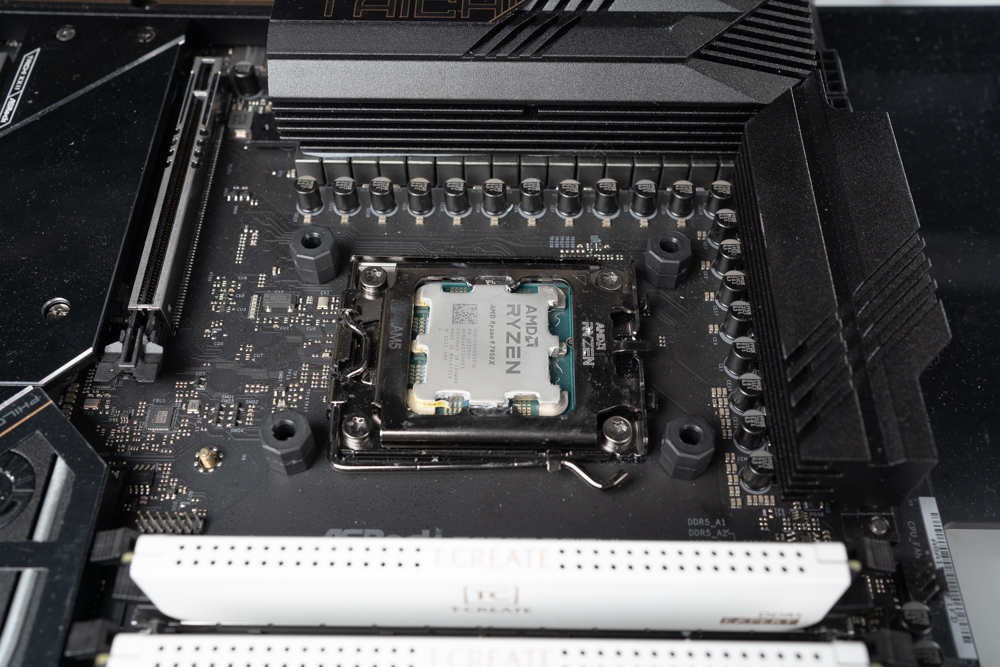
For this AMD platform, it’s noted that the motherboard’s original backplate is utilized, which simplifies the installation process by eliminating the need to assemble a separate backplate. This is a convenient feature, as it reduces the number of steps required for installation.
The removal of the motherboard’s original retention brackets is shown, and plastic standoffs have been installed directly onto the original backplate. These standoffs will support the mounting of the new CPU cooler.
This streamlined process is beneficial for users who want a quick and easy setup. The motherboard is now ready for the cooler to be placed on the CPU, after which the cooler’s bracket can be attached to these standoffs, completing the installation process.
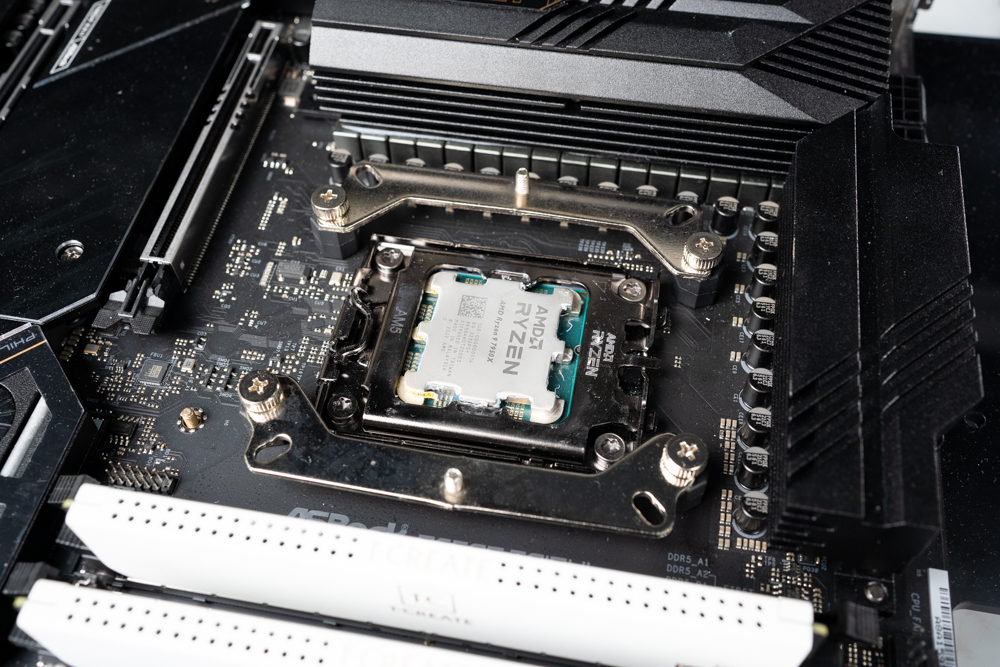
CPU socket on an AMD motherboard with the retention bracket in place, ready for a CPU cooler to be mounted. The bracket has been positioned over the original backplate and secured with screws, which will provide the mounting points for the CPU cooler.
This step is crucial because it ensures that the cooler will be properly aligned with the CPU and that it will have a stable base to sit on. The screws should be tightened evenly to ensure equal pressure distribution across the CPU’s IHS (Integrated Heat Spreader) for optimal thermal transfer.
With the bracket firmly secured, the next steps would typically involve applying thermal paste to the CPU, placing the cooler on top, and securing it to this bracket to complete the installation process.
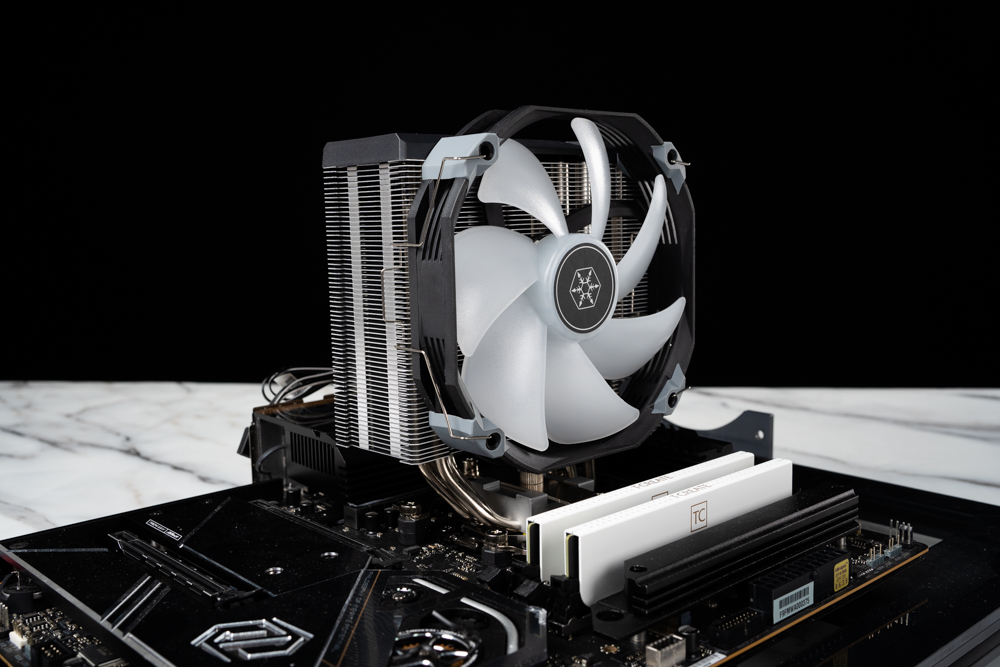
The image displays a fully installed ARGON V140 ARGB CPU cooler on a motherboard. The thermal paste has been applied, ensuring proper heat conduction between the CPU and the cooler. The cooler is attached and secured with screws, which is the final step in the physical installation process.
The large heat sink and fan assembly are positioned to facilitate optimal airflow, crucial for maintaining low CPU temperatures. The white fan with the SilverStone logo complements the black-and-white color scheme of the RAM modules and motherboard, which could be appealing to those who value aesthetics in their PC builds.
With the cooler now in place, the system is ready for testing to ensure that the installation was successful and that the cooler is performing as expected.
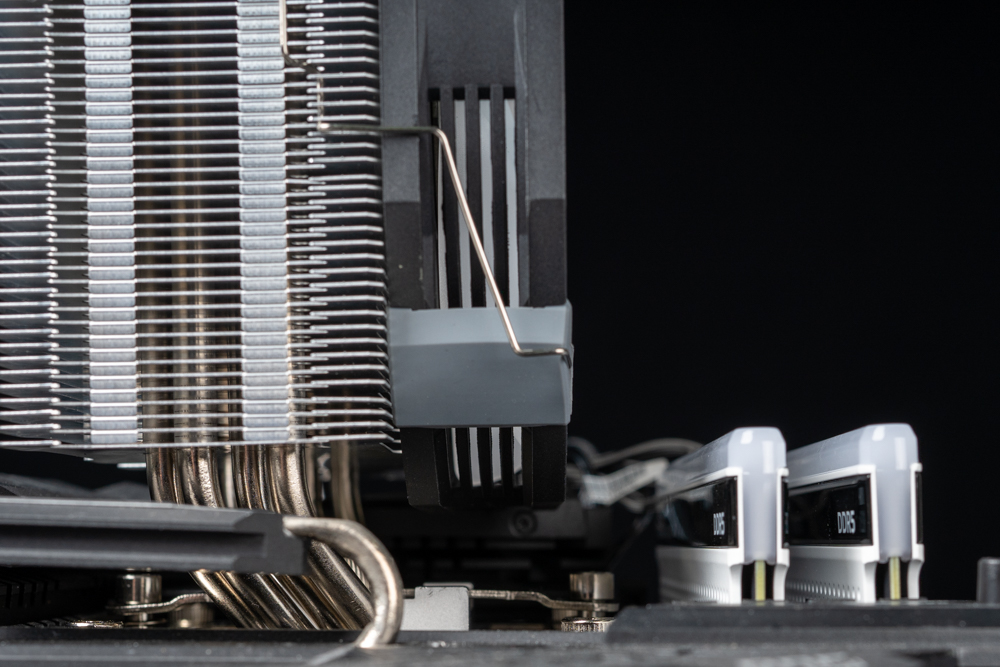
A side view of a computer system with the ARGON V140 ARGB CPU cooler installed next to the RAM slots. The perspective highlights the gap between the fan of the CPU cooler and the memory modules, showcasing the cooler’s offset design that allows for adequate clearance around the RAM.
This space is essential for multiple reasons:
- It prevents physical interference with tall memory modules, which can be an issue with larger coolers.
- It ensures that installing and upgrading RAM can be done without the need to remove the cooler.
- It allows for unobstructed airflow from the fan across the heat sink fins and around the memory modules, which can help with overall system cooling.
The careful design consideration taken to accommodate high-profile RAM modules ensures compatibility with a wide range of motherboard layouts and memory configurations.
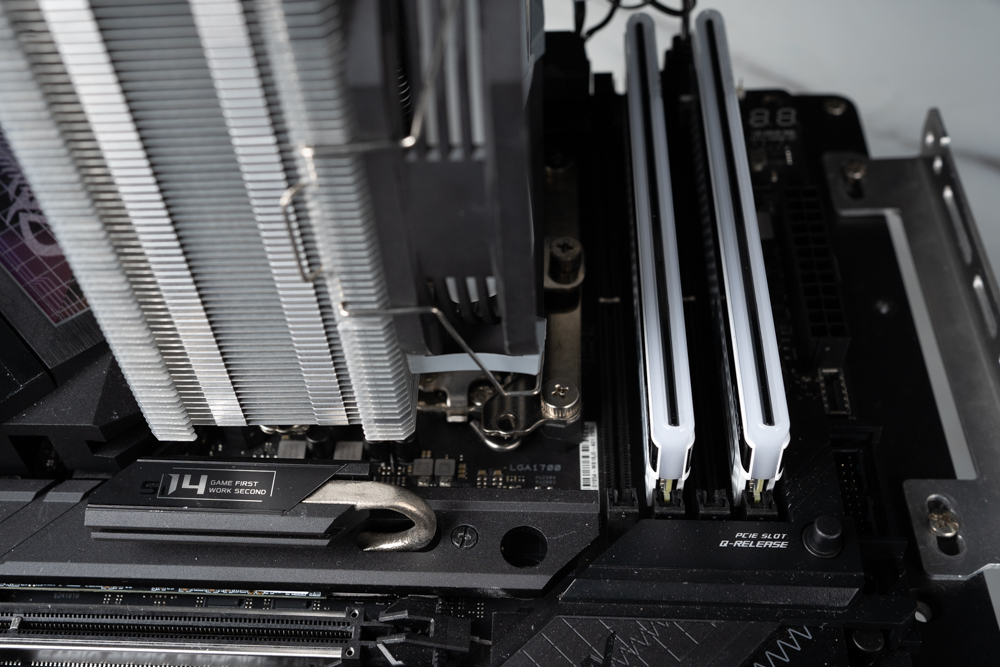
The installed CPU cooler is close to fully occupied RAM slots, emphasizing that the cooler’s design does not interfere with the memory modules. The adequate clearance ensures that even with the RAM slots filled, there is no contact or encroachment from the cooler, which is essential for users who may want to populate all available memory slots on their motherboard.
This design feature is particularly valuable for users who are looking to maximize their system’s memory capacity or who may wish to upgrade their memory in the future without the hassle of having to remove the CPU cooler.
The strategic engineering behind the cooler allows for full functionality of the system’s memory while maintaining a high level of cooling performance for the CPU, showcasing the balance between component compatibility and efficient design.
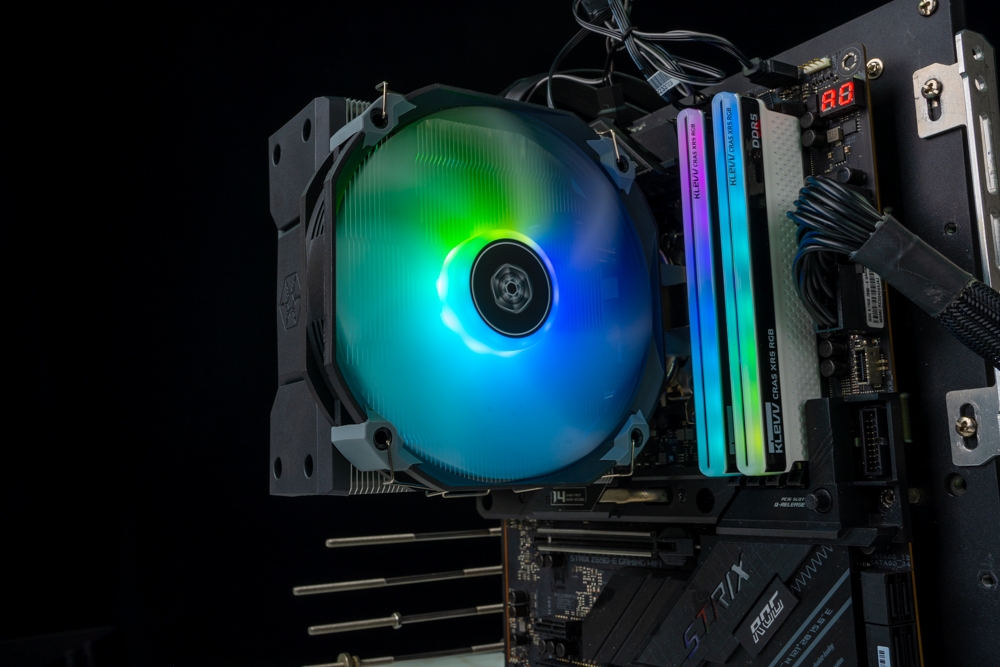
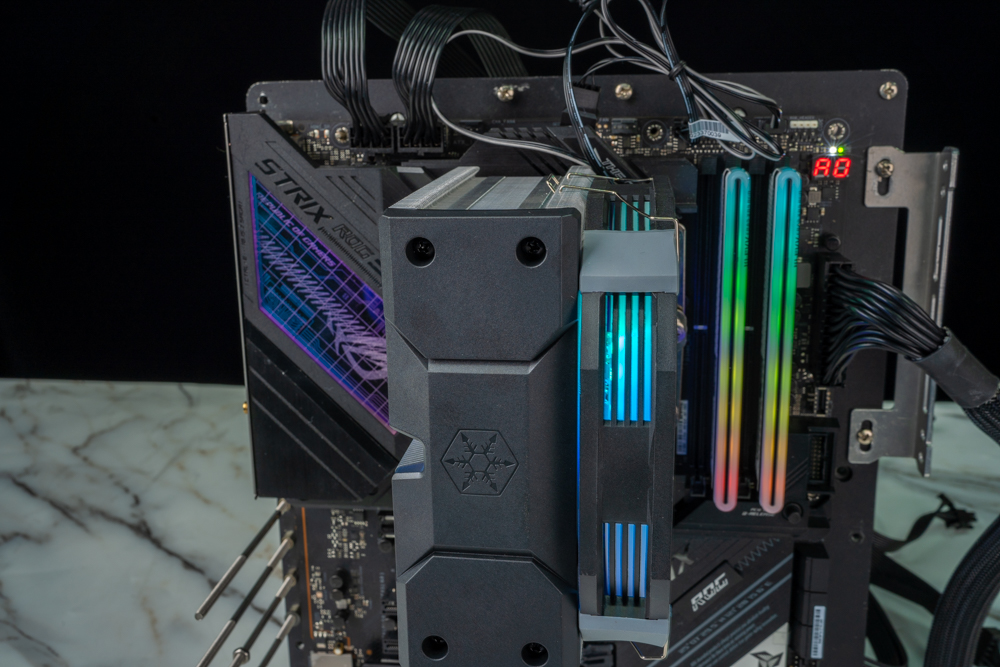
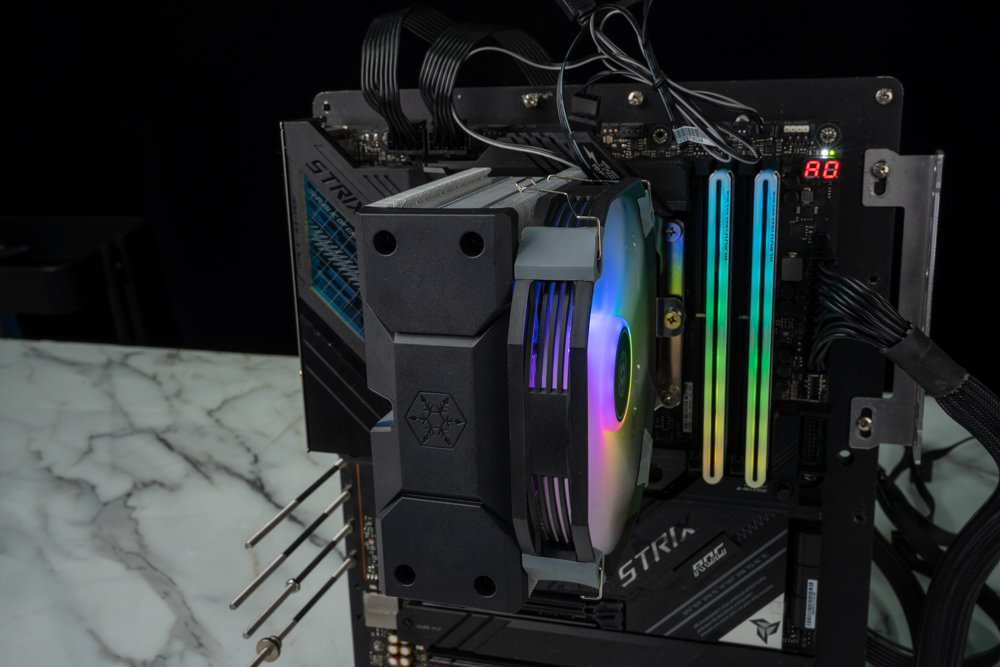
The series of images provided show the ARGON V140 ARGB CPU cooler installed on a motherboard, with the system powered on to reveal the cooler’s RGB lighting effects. The first image captures the cooler from a perspective that displays the RGB fan in full illumination, creating an attractive visual with the colors blending smoothly as they transition.
The second and third images offer side views of the setup, showcasing how the RGB lighting is visible from different angles, not just directly from the front. This is a desirable feature for users who have windowed PC cases and appreciate the aesthetics of their components.
The lighting enhances the visual appeal of the system, complementing the RGB memory modules and adding to the overall custom look of the build. The images demonstrate that the cooler’s design is not only functional, maintaining proper clearance for the RAM modules, but also stylish, contributing to the system’s dynamic appearance.
ARGON V140 ARGB Performance Review: Comprehensive Cooling Tests with Intel i7-13700K & AMD R7-7700X
In our latest hardware performance showdown, we pitted the Intel Core i7-13700K against the AMD Ryzen 7-7700X in a series of demanding thermal benchmarks. These tests were meticulously carried out under controlled conditions, including an ambient temperature of approximately 24°C and using the default settings in the BIOS.
The rigorous benchmarks included the AIDA64 FPU and CPU tests, as well as the 3DMARK Fire Strike Ultra and Cyberpunk 2077 standard tests. Our Intel test rig was equipped with the ASUS ROG STRIX Z690-E GAMING WIFI motherboard, accompanied by KLEVV’s DDR5-6200 32GB memory and NVIDIA’s RTX 4070 graphics card. The storage was handled by AGI’s AI818 1TB NVMe PCIe 4.0 SSD, and power delivery was ensured by the CORSAIR RM1000e. The system ran on Windows 11 Pro.
Similarly, the AMD setup featured the Ryzen 7-7700X slotted into an Asrock B650E TAICHI motherboard with Teamgroup DDR5-6400 32GB memory and the same NVIDIA RTX 4070 GPU. A PLEXTOR 512GB PX-512M9PeGN SSD was used for storage, with the same CORSAIR power supply, running the same version of Windows 11 Pro.
The results were intriguing. Under the AIDA64 CPU stress test, the i7-13700K’s temperature soared to 87°C, while the R7-7700X managed a cooler 67.7°C. The FPU stress test pushed the temperatures to their limits, with the Intel chip hitting 100°C and the AMD chip peaking at 77.1°C.
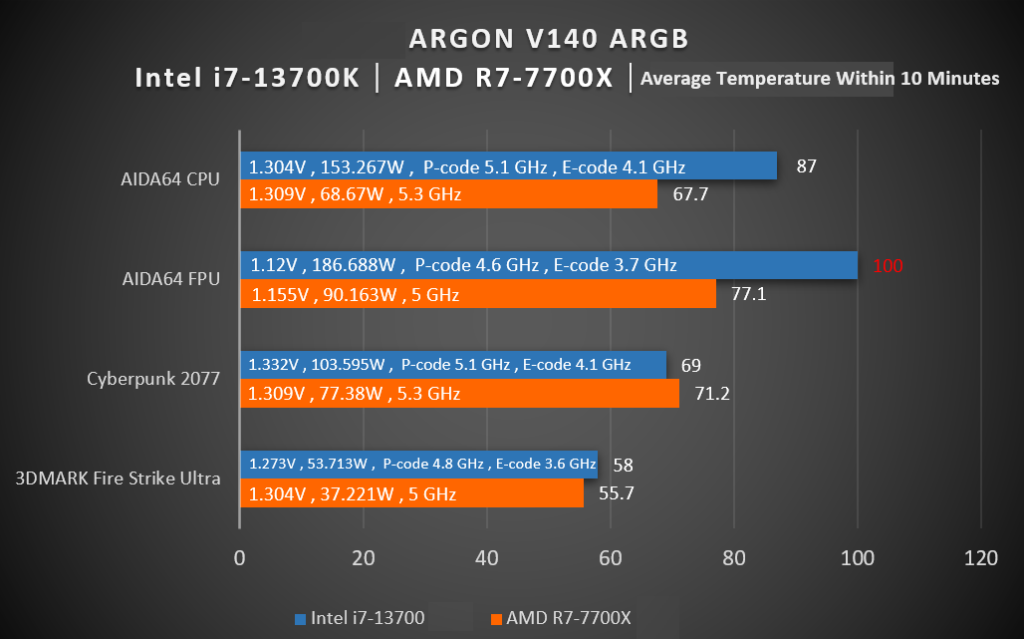
Conclusion
Upon completing practical tests, it was evident that the ARGON V140 ARGB cooler showcases superior performance on the AMD R7-7700X when compared to the Intel i7-13700K under high load conditions. The temperature was effectively maintained between 60 – 70°C, allowing the R7-7700X to deliver robust performance. Although high-load scenarios are rare, the ARGON V140 ARGB still performs satisfactorily on the i7-13700K under normal everyday use.
In terms of noise reduction, the ARGON V140 ARGB fan is designed with an all-encompassing shock-absorbing rubber that minimizes vibration. Throughout our testing, the fan remained virtually inaudible even at full speed, demonstrating a remarkable prevention of resonance. Aesthetically, the cooler breaks away from traditional square designs, opting for an octagonal shape, which may appeal differently to individual tastes.
Priced at NT$1390, the ARGON V140 ARGB stands out as a commendable choice for gamers looking to upgrade from the stock coolers of i7 and R7 processors. This information serves as a reference for enthusiasts considering their cooling options.
If this article is helpful for you, please share this article with your friends on social media. Thank you!
This article is based on the personality of the reviews. You are responsible for fact-checking if the contents are not facts or accurate.
Title: SilverStone Argon V140 ARGB CPU Cooler Review: Ultimate Cooling Performance for Intel LGA and AMD AM Platforms